By: debbie lynn elias
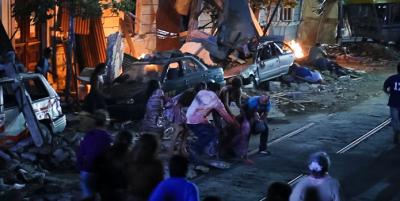
AFTERSHOCK is mind-blowing entertainment! F**king genius fun! A shock-filled high octane thrill ride that never ends. Think Springbreakers meets Earthquake meets The Impossible.. Strangers from a variety of countries come together in Valparaiso, Chile to vacation, party and have a good time. What they don’t count on is a 10.0 earthquake to bring their good times crashing to the ground. Written by Eli Roth, Nicolas Lopez (who also directs) and Guillermo Amoedo, AFTERSHOCK is no holds barred moviemaking. There’s a little bit of everything here and all tied up with a super-saturated colored bow and with each end tie you pull on, you get closer and closer to the deliciously wicked ultimate conclusion. Just when we think we know what’s going to happen, just when we think it’s all over, WHAM, director Nicolas Lopez shocks us with something else.
Right off the bat, Roth and Lopez make a smart choice by setting the film in Chile. Party hearty. Young, vibrant, high energy, pulsating life. The music and lifestyle are the life’s blood, pulsing, pulsating and pumping. And oh my. What’s that we see pulsating and pumping the rest of the film? Why, it’s blood pumping out of severed arteries to arms, dismembered hands and legs, spurting out of mouths of abdominally crushed victims, pulsing from bodies as 500 pound light fixtures and Virgin Mary statues go splat on top of people, pulsing out of backs, chests and faces when axes slice into you. Pulsing life, pulsing blood. Yep – pulsing.
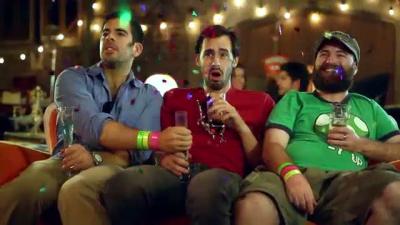
The eclectic mix of characters is perfect. International, global appeal, people from all walks of life who ultimately have to rely on each other to survive. (Well, let’s just see how well human nature can conquer the fury of Mother Nature.)
As the orthodox Jewish single father “Gringo”, Eli Roth is delicious, playing the nebbish to the hilt to hilarious effect, but also with a fish-out-of-water devoted dad touch. Writing the character for himself, Roth recalls thinking, “This is great. It’s in my zone. I know I can play the comedy. I can play funny and dorky, but I liked writing a guy that was a modern single dad with an 8-year old daughter. And he’s a dork.” Using that basis for the character enabled and allowed Roth and Lopez to then “build the minutiae of the little problems in life that seem so important until everything is put into perspective. . .We put such importance on these minor problems and it generally takes a tragic event or a death to put everything in perspective. But we really wanted to take our time and show a guy that was human and flawed.”
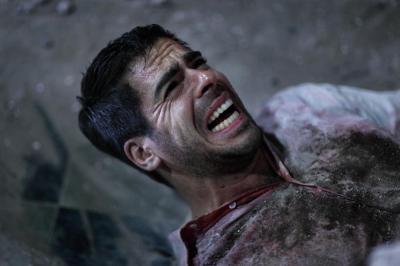
And who doesn’t know a Pollo? Nicolas Martinez is effervescent delight as the slightly rotund man-with-the-means; the man who knows everyone, gets whatever he needs or whatever you need or want. A friend to all, and while seemingly superficial, is really a friend to the end and will give his right arm for you. Oh no. wait. Ariel is the guy to give his right arm for you – especially when trying to save his favorite bartender. Talk about insecure sweetness! Ariel Levy is a doll.
As for the ladies, Andrea Osvart really has the chops to go into the action genre. Smart, calm, but with a panic attack stricken edge, Osvart gives Monica sensibility and grit, much like Angelina Jolie. “The biggest challenge for me was to play [the panic] well, to have this anxiety problem. . .I didn’t really prepare for that. I just trusted myself.” Natasha Yarovenko’s Irina is believable, sincere and likeable. But then we turn to Lorenza Izzo. Gotta have a nut job and her Kylie is it. Arrogant, frenetic, over the top fireball of energy – she makes me think of Cyndi Lauper’s “Girls Just Wanna Have Fun”. Izzo could be the poster child.

A very physical movie, AFTERSHOCK required the cast to do their own stunts. As Izzo notes, “When you’re there, on the day, you have to go with what works. . .the stunts were really hard.” Given “a lot of freedom” by director Lopez within the context of the film, “The whole shooting of the movie made it more ‘aftershocky’. . .We would get to set and you would have to work with the circumstances. It was in the middle of night, it was cold, we had a certain time to work in the funicular scene, it was tough.” Echoing Izzo’s sentiments, Osvart adds the all important, “It was dangerous.”
Going against type and tossing patented character kill-off theories to the wind, Lopez and Roth deliver fantastic thematic elements, tossing in everything but the kitchen sink, but I’m sure if I look hard enough, I’ll find that too. Clues are inserted throughout the dialogue essentially giving us hints of what’s to come, but those teasers are just that, as Lopez holds back on satisfying the tease as long as possible and then just zings us with WHAM in your face. It’s not enough to get crushed by holy concrete, let’s get set on fire, too. Not enough to push an axe into someone, let’s step on it so all the blood and guts pop out. But beyond the visual aspects of AFTERSHOCK are the moral aspects and the story construction itself. For Roth, it’s important for the audience to note that “this is a fictionalized movie. It’s based on stuff that happened [a 10.0 earthquake that did strike Chile] and this is what you’re in for.”
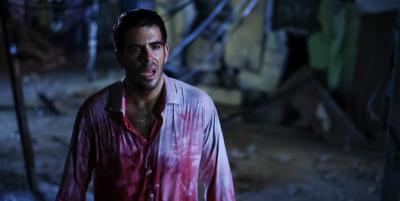
Expounding on the genesis of AFTERSHOCK, Roth recalls director Lopez “started telling me about the earthquake and what is was like living through that. And it was terrifying. He said it was like 3:30 in the morning and he was sitting there, it was the last weekend of summer. He said he saw his Nintendo Wii fly across the room. He told me, ‘Once you see your South Park dolls flying across the room, you know it’s serious.’ Lorenza Izzo was in a club. Everyone was drunk and partying and then next thing you know, her friend’s hands got cut off and you’re looking for your friend’s hands. But if another aftershock hits, the whole club’s collapsing and everyone’s dead. [Lopez] said, ‘Dude, it was hardcore. . .people were crushed under speakers, crushed under the ceilings.’” These real life experiences and are all authentic elements that comprise elements of AFTERSHOCK.
Great care is given to crafting the story and messaging and “to really make the film about moral choices.” Commentary on human nature is discerning and reflective, noting that for people who are relatively intelligent, telling is that fear and panic make rational thought disappear and new considerations come into play, not the least of which the collapse of society – “the literal and figurative collapse of society; the veneer of society. Everyone behaves and then this happens and you go back to some primal survival state.” As Roth describes it, “The earthquake happens and what do you do? You’re running by a building and you hear a crying baby. We’d all love to think we would run in and save that baby, but if you have a kid, are you gonna do that? Are you gonna risk the building collapsing especially when they’re all falling down [around] you like a house of cards?. . .You want to save yourself, you want to save your friend but if your friend is slowing you down, and if you spend too much time caring for this person, then you’re all gonna get killed. Or you save this one because this is the one that speaks Spanish and you need them. Where do you draw the line and what moral choices do you make? We wanted to show the ramifications for both – doing the thing to help your friend and doing the thing to preserve yourself. That’s what made the movie scary – really building the tension in these moral choices and then eliminating people in a way that made the audience go ‘Oh fuck!’”
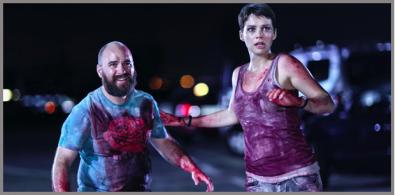
Thanks to Director of Photography Antonio Cuercha, camera work is superb. Fast-paced, angular, creative, a lot of hand held that pulls us into the moment – especially during the quakes. The visual palette and tone is eye-poppingly gorgeous from the vibrant multi-colors to the super saturation to the calm beauty of the seacoast from atop the funicular and all showcased with a high gloss clarity. A real visual stunner.
Celebratory is not only the FX design – from the quake destruction to electrical lines blowing to the massive amount of human stuntwork – but the fact that the majority of the “FX” are practical effects and not CGI. When there is concrete falling, it’s not foam. It’s concrete. Important to Lopez and Roth was to make the movie “look big. We didn’t want CG. So many disaster movies look like you’re watching someone else play a video game. . .but you don’t feel that connection. . .We wanted to use as little CG as possible. [We were] really destroying things, really smashing things and just make this intense thrill ride.” According to Lorenza Izzo, who lived through the Chilean quake, “The practical effects, I think that gives the movie something really special. . .and watching the movie, you feel it too. You can actually see things breaking. You can actually feel the concrete falling and floor moving. I think that was one of the greatest things they did to portray the reality of the earthquake.” Andrea Osvart agrees. “In our movie, why it works so well, is because whatever it felt, it felt for real.”
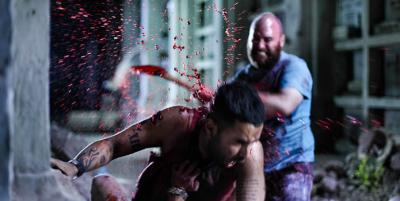
And then there’s the music! WOW WOW WOW! And I’m not talking the techno. I’m talking the scoring and lush orchestrals that are used in the most untypical fashion. Where you think there would be a poignant soft musical movement, we get a rousing John Williams type effect like Darth Vader marching with the storm troopers. The music is for the most part, set inopposite to the story at any given moment; simply brilliant design as it creates an emotional dichotomy within the audience with the subconscious relying on being led by the auditory sense while the visuals are leading you elsewhere. Just adds to the thrill and excitement and yes, suspense, which then makes the story and shocks that much better!
AFTERSHOCK shocks you into the land of the living thanks to death and destruction. AWESOMELY COOL!
Directed by Nicolas Lopez
Written by Nicolas Lopez, Eli Roth, Guillermo Amoedo
Cast: Eli Roth, Andrea Osvart, Ariel Levy, Lorenza Izzo, Nicolas Martinez, Natasha Yarovenko












